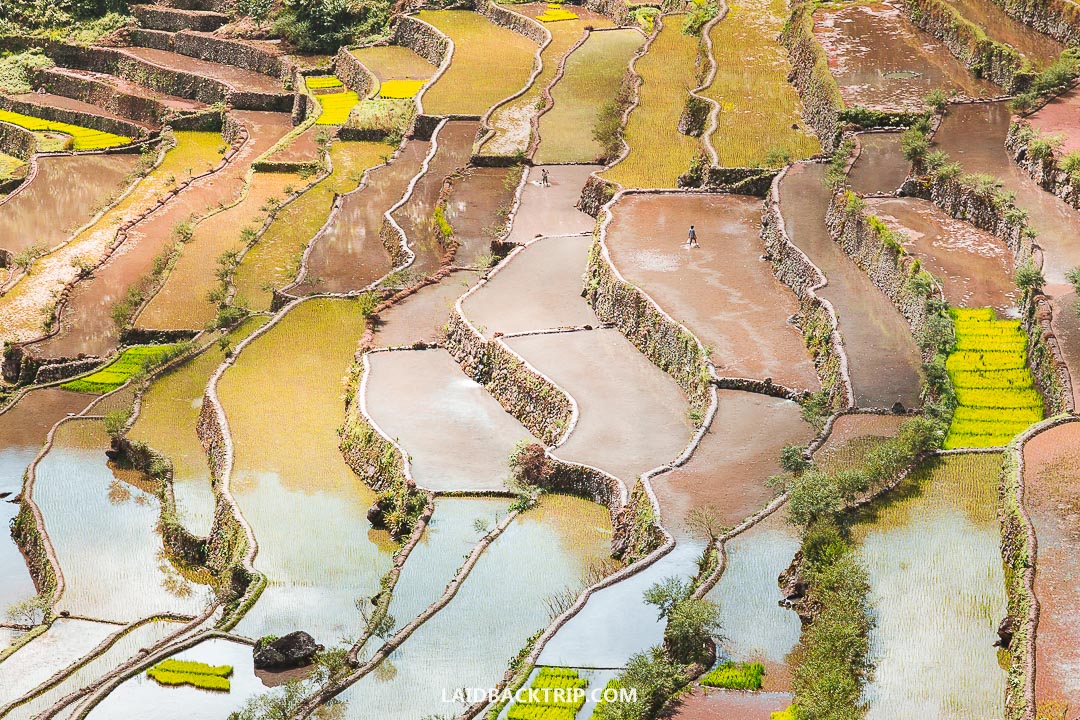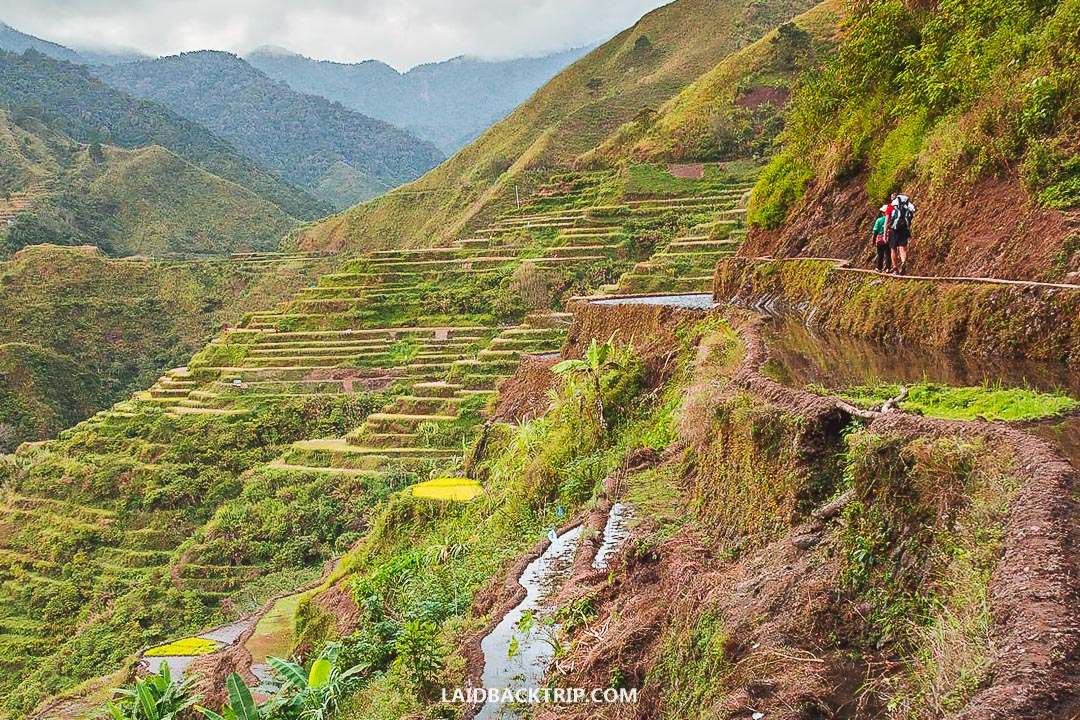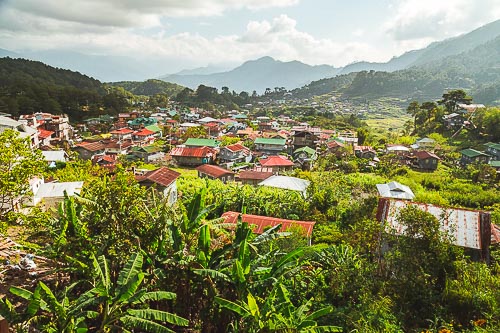Banaue Rice Terraces Hike: Batad - Cambulo - Pula - Banaue
Hiking is the best way how to explore stunning rice terraces in Ifugao province of the Philippines even more thoroughly. Read our comprehensive hiking guide on the trail leading from Banaue to Batad, and then via small settlements Cambulo and Pula back to Banaue.
The Philippines is a country famous for thousands of islands and sandy beaches, but we found our favorite place more than 1500 meters above sea level, on Luzon Island near Banaue.
Banaue village, despite its size, is a transportation hub for visiting stunning rice terraces in the near surrounding. Rice terraces were built more than 2000 years ago by indigenous Ifugao people who had to figure out how to grow their crops in such a difficult terrain like the Cordilleras are, as the Cordilleras are the place where you can find steep hills and deep valleys almost everywhere.
That's why they started building terraces made of mud or stones, and the terraces remained here until today, and not only they are absolutely beautiful, so a large number of international travelers arrive in the area every year to admire them, but most of the locals still grow the crops on terraced fields their ancestors created.
Although it is possible to see the rice terraces from the viewpoints around Banaue, the truth is, that because of urbanization, those terraces are not in UNESCO as locals built their houses near the fields, and a bit destroyed the visual beauty (although we completely understand that the primary function of the terraces is to grow rice and it makes sense to live nearby).
But in case you really want to see one of the most spectacular places in the area, head to Batad, a village near Banaue.
Once you arrive in Batad, an awe-inspiring amphitheater will open right in front of you, and we promise you will be facing one of the best photogenic opportunities in your life.
It is possible to arrive in Batad only to soak up the views, taste rice wine and then carry on in your Philippines journey, but if you have two to three spare days, you should not miss an opportunity to hike among the rice fields.
We made the hike from Batad via Combulo and Pula back to Banaue, and it was one of the best things we've done in the country.
In this hiking guide, we've put together everything you need to know about Banaue - Batad - Cambulo - Pula - Banaue trek, and we also share information on how to get to the trailhead, where to sleep, what to pack, and whether it is better to hike on own or with a guide.
ARRIVAL IN BANAUE
To start the hike, you must arrive in Banaue first.
We've covered more thoroughly information on how to get to Banaue in another post Comprehensive Guide to Batad and Banaue Rice Terraces, but generally, you will be easily able to get to Banaue from either Manila, Vigan, Sagada or Baguio, although some connections require bus transfer.
You can check bus schedules and even buy your bus ticket here.
HIKE'S TRAILHEAD AND HOW TO GET THERE
Banaue - Batad rice terraces hike is not a full loop unless you want to walk on a road, so you can choose where will you start and what direction will you walk.
Generally, we think it does not matter, but most of the travelers, including us, usually start in Batad.
How to get to Batad trailhead | To get to Batad, take a jeepney (either public or private) or tricycle. Again, check out our Banaue/Batad post for more information. Normally, the jeepney leaves Banaue once a day, but not regularly.
How to get to Jump off to Pula | Another option is to take a jeepney to an intersection 9 kilometers from Banaue called Jump off to Pula. It is on the way to Bontoc and Sagada, so it is possible to take any transport heading this direction or again, hire a tricycle.
Where to stay in Banaue | In case you did not make it to Banaue for the last jeepney to Batad or Jump Off to Pula, and do not want to pay for more expensive private transport, or in case you are looking for an accommodation after finishing the hike, it is possible to find in Banaue several hotel and hostel options.
Budget: Rice Homestay | Budget: Peoples Lodge and Restaurant | Mid-range: Baleh Boble Guesthouse
RICE TERRACES HIKE DIFFICULTY
The hike around the terraces is not that long, the total is 21.5 kilometers, and it is doable in two days (although you can take it more slowly and finish it in three days), but hiking up and down the stone steep steps is not that easy as it could seem, and you should consider your level of fitness.
We think every average hiker should be able to finish the trek, but in case you have knee problems, take either trekking poles or find a wooden stick along the way which will help you to keep the balance.
ENTRANCE FEE
Once you arrive in Banaue, head to the tourist office (some of the buses, for example, the one from Bontoc stop there), and pay 20 PHP environmental fee.
Once you arrive in Batad, you will pay one more environmental fee, 50 PHP. It is a very small contribution to see a place which is often nicknamed the Eight Wonder of the World.
HIKING INDEPENDENTLY VS TREKKING WITH A GUIDE
Generally, it is better to hike with a guide than independently, because the route among villages is not well-marked, and it is quite easy to get lost in the fields, or you most likely won't be able to find the best way on own, and climbing the high stone walls with heavy backpack is not so funny as it can seem at first.
You have several options on how to arrange a guide.
The most expensive option is to reserve a tour online, on the other hand, you can be sure the quality should be the best.
Another option is to arrive in Banaue and find a guide there.
You can either ask in the tourist center or visit one of a few travel agencies, or there is also a chance you will be approached by a guide once you arrive on the bus station in Banaue. A good idea is to team up with some other travelers you will meet on a bus or in Banaue to share the cost.
Don't be afraid to bargain a bit, but a guide should usually offer you package consisting of transport, accommodation, and food, and you should pay around $40 - $50.
It is also possible to find a guide directly in Batad, but expect to meet only a person who will show you the way, as people in the area still do not speak much English. But as this was the cheapest way available, this is what we did.
When we arrived in Batad, we teamed up with several people who wanted to go to the waterfall with a guide.
We paid a small fee, then, from the waterfall to Cambulo we walked on own as we read the path is pretty well visible, but on the way, we met a lady, who offered us her services. As we knew we should take a guide between Cambulo and Pula, we agreed, and the lady led us for the rest of the day to Pula.
Then from Pula to Jump Off to Pula, we walked independently again.
WHEN TO HIKE IN BANAUE AREA
The rainy season on Luzon Island is between June and September when you can expect wet weather conditions, and there is also a chance of landslides.
As rice terraces change color throughout the year, there are some more and less popular seasons to hike in the area, but although we visited the place in January which is usually considered not the best time as rice fields are not that green, we were not at all disappointed.
Probably the best time to visit Batad is between April and May, and then between October and November, when the fields are in their greenest.
On the other hand, when it rains, the flooded terraces reflect the sky, and it gives visitors a chance to see rice terraces in a different way.
ACCOMMODATION ON THE TREK
Usually, it is not necessary to reserve accommodation in advance, but you can book a hostel at least for the first (or last) night in Batad, as it is the most touristy place.
Most of the travelers usually arrive to see the rice terraces amphitheater and then do not continue to Cambulo and Pula. There are a couple of accommodation options in Batad you can reserve online:
Budget: Batad Transient House | Budget: Lhorens Inn and Restaurant
When hiking with guides, they usually know the best accommodation options in either Cambulo or Pula.
Do not expect anything fancy, hostels are usually very basic, but we never needed anything else but a bed with a blanket (we always carry cocoon to sleep in) and water (shower was cold).
Expect to pay anything between PHP 200 - 300 per person per night.
FOOD ON THE HIKE
It is not necessary to carry food unless you are used to eating snacks when hiking (but it is possible to buy some in the villages as well). In every settlement is a restaurant serving breakfast, lunch or dinner, and prices are reasonable, with a small surcharge caused by the remoteness.
Water in the Philippines is not drinkable, so you must either buy bottled water every day, or you can think of purchasing filtered water bottle to lower your plastic footprint.
BANAUE - BATAD - CAMBULO - PULA - BANAUE ITINERARY
Although it is possible to stay in every village on the way, we decided to skip sleeping in Cambulo as we arrived there early just to have lunch, so we finished the hike in two days (with an arrival to Batad from Banaue, the whole visit of the area took us three days), but you can adjust the itinerary according to your needs.
Day 1: Banaue - Batad
As we were traveling from Sagada that day, we were pretty lucky to find a jeepney waiting on the market which was about to leave to Batad.
There is usually only one jeepney in the morning, but the schedule and frequency can change depending on the needs of the locals.
We paid PHP 50 per person, and the van took us as far as it could because there was road construction. From this point, we had to walk another twenty minutes to the village, from where for the first time we could see why this destination is so well-rated among travelers.
Until the evening we sat on a terrace, drank tea and enjoyed the amazing views.
Day 2: Batad - Cambulo - Pula
In the morning we met several French guys who were heading to Tappiya waterfall with a guide, and we decided to join them.
The guide led us in the heart of rice terraces, we had to walk narrow stone walls, and uneven steps down to the valley, while we were passing by locals working on the fields.
After approximately one hour we reached an absolutely stunning waterfall where it was also possible to swim, but we decided to carry on.
One of the French guys was headed the same direction as we did, so we agreed to walk together and eventually share a guide.
The first section from the waterfall to Cambulo settlement was leading uphill, it was hot, and as we were carrying all our stuff in the backpack, we found this part pretty hard, but once we reached the rim of the terraces and path leading to Cambulo, the trail was much easier.
It is three kilometers from the waterfall to Cambulo village, and approximately one kilometer before the village we met a lady who offered us her services as a guide, and we agreed, as the price was reasonable. She did not speak English, but we could tell she walked among the terraces her whole life.
When we arrived in Cambulo, we had lunch and watched for a while men playing dama game.
Then, we carried on another six kilometers to Pula. This section was pretty challenging as we had to climb a hill at the beginning. When we reached the top of the hill, we were completely drenched with sweat, but the views were rewarding.
It did not take long, and we reached Pula, a small settlement which at that time did not have electricity (there should be electricity now). We took a cold shower, ordered dinner from a lady running accommodation in the village, and went to bed early surrounded by complete darkness.
Day 3: Pula - Banaue
As we were using Maps.me, the last section between Pula and Jump Off point to Pula seemed easy, so we decided not to hire a guide for the last day.
In the morning we were not in a hurry, so we went to a local school, and watched kids who were preparing for their class. They were singing the anthem and pulling out the flag, and overall, the experience was very touching.
Later, we continued for 11 kilometers to the end of the trail, again accompanied by beautiful views of rice terraces. The trail was pretty muddy although it did not rain, so our boots were a mess.
Once we reached the end of the trail where the hiking trail connects with a road, we walked down and tried to hitchhike vans passing by as we did not want to walk another nine kilometers on a busy road, especially when there were many strayed dogs everywhere around.
Luckily, one van stopped, and it took us back to Banaue, where we immediately bought an overnight bus ticket to Manila and waited in a restaurant for departure.
We were pretty exhausted but super-happy for what we've just done.
Our Tip: Use Maps.me for planning the route. Have enough cash with you, it is not possible to pay by credit card.
Travel Insurance
We never leave home without travel insurance that was designed to cover our expenses if something goes wrong during the trip.
Travel insurance protects against theft, flight delays, injury, illness, cancellations, and much more.
World Nomads provides travel insurance for travelers to cover their trip essentials, including sports and adventure activities.
SafetyWing is affordable travel insurance for backpackers, long-term travelers, and digital nomads.
Travel smarter and safer!
WHAT TO PACK
Weather in the area is quite stable as well as temperatures. When doing the hike in monsoon season, remember to pack enough waterproof items and extra dry clothes.
Here are several essential things you should pack for hiking in the Cordilleras.
Rain Poncho | Trail Walking Shoes for Him & for Her | Trekking Poles | Daypack for Him & for Her | Fleece Jacket for Him & for Her | Silk Liner | Filtered Water Bottle
Travel Resources
Here you can find links to all the travel resources we use and which you might find helpful when planning your next holiday.
Accommodation: When looking for accommodation, we usually search hotels via Booking.com or Hostelworld.
Tours: Although we love to travel independently, some places are better to visit with a guided tour.
We prefer GetYourGuide for its easy-to-use interface and solid reputation. Another great alternative is Viator.
Rental Cars: When going on a road trip, we always use Rentalcars.com, a reliable site for booking a rental car in advance.
Flight Tickets: When looking for flight tickets, you can search Skyscanner to find the best price.
Travel Insurance: World Nomads and SafetyWing cover against risks of travel.














